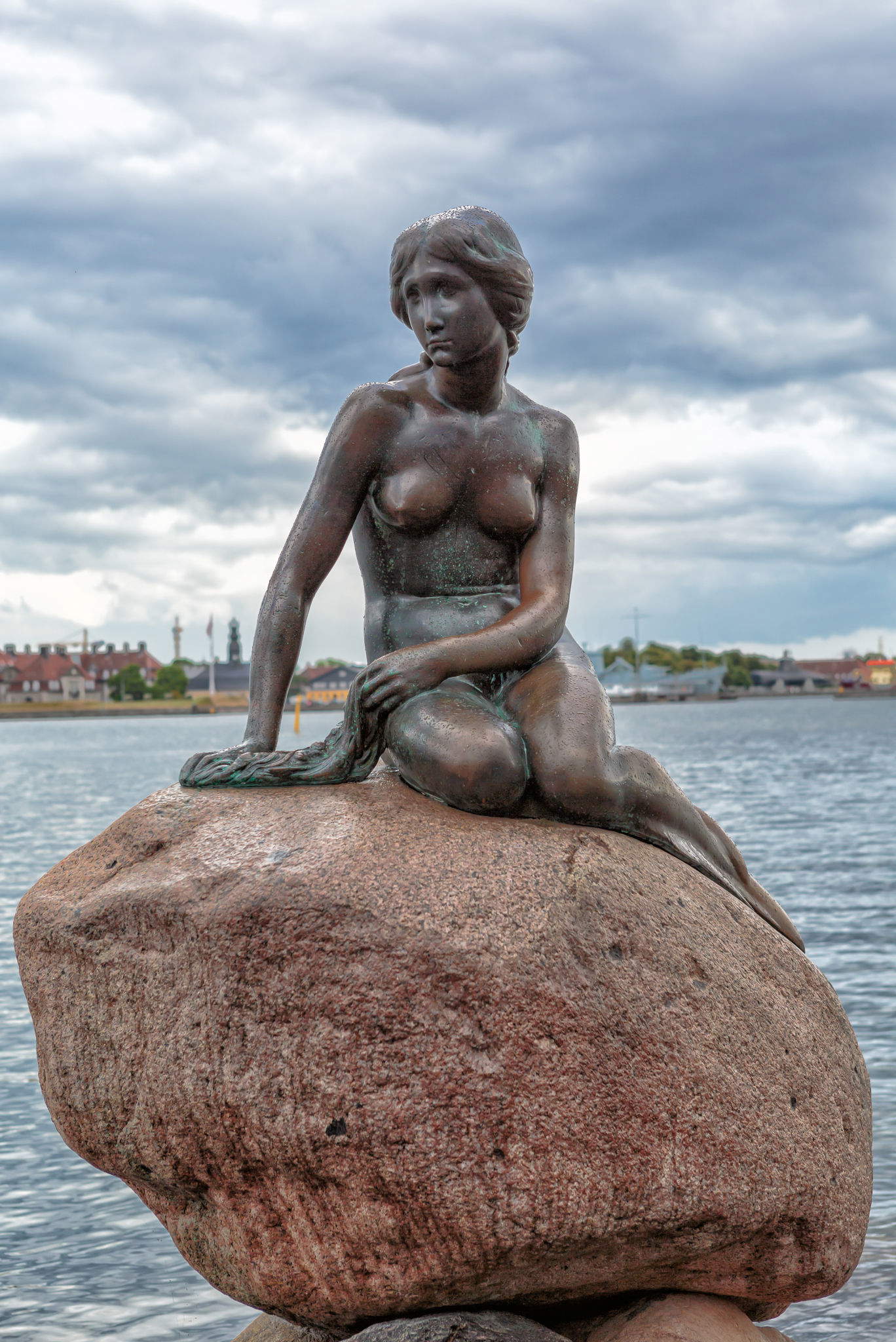by Noemi Capoccia , published on 07/08/2025
Categories: News
/ Disclaimer
Artist Peter Bech’s four-meter-tall sculpture has been at the center of a controversy in Denmark. Accused of offending cultural heritage and the female body, it was rejected by Dragør Municipality. The case has raised much debate.
It is causing much discussion these days in Denmark about Peter Bech’s The Great Mermaid(Den Store Havfrue). It is a granite sculpture that theDanish Palaces and Cultural Heritage Agency recently asked to remove from Dragør Fort (Denmark), considering it incompatible with the historical value of the site. That of the Bech mermaid is an affair that stems from decisions made several months ago and deserves to be reconstructed with greater clarity. To begin with, the Danish agency’s decision was reported last March 12 by the Danish newspaper Dragør Nyt, which told how the municipality rejected the artist’s offer to donate the sculpture, including transportation, for a new location on public land in the town.
Peter Bech, a Dragør resident artist, had created the Mermaid for his own restaurant located in Langelinie, Copenhagen. Placed near the famous Little Mermaid between 2006 and 2018 (it had also been removed from there following complaints from residents, who had called it a fake and vulgar mermaid), the four-meter-tall sculpture (carved in Beijing and designed by the artist himself) had then been moved to Dragør Fort in agreement with the site’s tenant. In any case, the work never went unnoticed and continued to generate mixed reactions, until the recent intervention of the Cultural Heritage Authority.
In an effort to preserve it from eventual permanent removal, Bech therefore proposed the donation to the municipality, but the Climate, Planning and Enterprise Commission, on the recommendation of the city administration, rejected the proposal. Indeed, the reason given by the administration itself, and also reported by Dragør Nyt, lies in the lack of consistency with the history of the area. “The mermaid sculpture is difficult to integrate, as it is not related to the history of Dragør and can therefore be considered an element that does not contribute to the history of, for example, Dragør Old Town or the harbor,” the newspaper reports.
Dragør Nyt at this point also releases Bech’s comments. “There are mermaid sculptures in many cities, and Dragør is a port city. So it would make perfect sense to find a place for them here. Since I moved to Dragør a few years ago, I felt treated well and very welcome. So I wanted to give something back and offered the municipality to install the siren near the water. It took me two years. The reason was that my restaurant customers were often disappointed that the Little Mermaid was so small, so I wanted to offer them a different experience. Over the years that it has been displayed in front of the restaurant, it has been photographed thousands of times (…) It has been placed in this elevated position to show that women have won an independent place over time and to show the respect they have gained. I think it is in line with the desire to have more statues of women in general. Another element is that her position conveys self-confidence and reflects the Danish view of the sea that she dominates, both historically and today. It has been called kitschy, an eyesore and a garden gnome, but others really like it.”

The Great Mermaid by Peter Bech. Photo: Dragør Nyt
According to the newspaper, Helle Barth, chairwoman of the Climate, Urban Planning and Enterprise Commission, appears to have confirmed the outcome of the decision-making process instead, while admitting the body’s difficulties in rejecting a work offered free of charge. “It was not an easy decision to turn down the sculpture. It was a really tempting offer, but it is difficult to fit in at Dragør, so we politely declined the offer,” Dragør Nyt reports.
The controversy, however, has crossed the boundaries of administrative debate. According to Mathias Kryger, art critic for the Danish magazine Politiken, the Siren should never have been installed in the city. Interviewed by TV 2 Kosmopol, Kryger spoke of the work being too ugly and pornographic, and pointed to the responsibility that institutions have in deciding which works should occupy public space. “There is a huge responsibility on the part of those who decide which statues will adorn public space. The sculptures must provoke thought and be well thought out. I don’t think The Great Siren is characterized by that,” Kosmopol told TV 2.
The discussion has since broadened, taking on broader contours involvingcultural identity, the representation of the female body, and criteria for decorum in shared space. In the pages of the Berlingske newspaper, journalist Sorine Gotfredsen instead called the statue “one man’s hot dream about what a woman should look like,” arguing that such works do not foster broad acceptance of women’s bodies by women themselves. “It is particularly encouraging that there has been dissatisfaction with the mermaid statue currently towering in Dragør,” wrote Gotfredsen, who was also quoted by the Guardian in a dedicated article.
The debate, according to Berlingske editor Aminata Corr Thrane, has transcended the realm of aesthetics and even entered the realm of body shaming. As the Guardian writes Corr Thrane criticized the obsession with the academic shapes and proportions of women’s breasts, recalling that Bech’s Mermaid is mostly accused of having larger breasts. “Should naked female breasts have a specific academic shape and size in order to appear in public?” he asked in his statement reported by the British newspaper. And again, “On the other hand, she has larger breasts, and therein lies the problem. Perhaps the two statues, the Big One and the Little Mermaid, represent two sides of the woman and the eternal tightrope of what a realwoman is. And maybe also what a wrong woman is.”

The Little Mermaid in Copenhagen. Photo: Avda-berlin
An additional element to take into account concerns the context in which the discussion about The Great Mermaid takes place. Indeed, the debate comes at a time in history when female statues in Danish public spaces still remain heavily in the minority. According to a count released in 2024 via a statement by the Danish Palaces and Cultural Heritage Agency, only 31 of the 321 statues surveyed represent female figures.
“The numbers almost speak for themselves: only 31 of the 321 statues and busts in the city depict women, and there are more statues of mythological creatures in Copenhagen than women,” writes Culture Minister Jakob Engel-Schmidt. “It is absolutely crazy. Is this really the image in which the next generation will grow up? Especially when you consider how many crucial achievements in society are due to women. We all need role models to look up to and to give us an understanding of our common past. As a minister, I would like to use my voice to pay tribute and recognize the many women in Danish history. That is why I want to establish a committee to identify which women to pay tribute to with statues. I then hope that municipalities, foundations and companies will help promote development. As minister, I will definitely do my part to ensure support for such projects.”
The data collected came from a survey conducted by the newspaper Jyllands-Posten in the summer of 2023, as part of a series of articles devoted to the sculptural presence in the country. In any case, despite the rejection by Dragør, the Mermaid may indeed find a new location, away from the fort and away from criticism. The deputy mayor of the municipality of Guldborgsund (in the region of Selandia), René Christensen, told the newspaper Jyllands-Postenthathis municipality would be willing to accept the work, thus indicating a willingness to leave room for even controversial art forms.
“In Dragør they have decided to remove the controversial sculpture The Great Mermaid,“ Christensen writes. ”This is a decision I find regrettable and symptomatic of the lack of space we often give art in public spaces. To me, The Great Mermaid is a beautiful work of art precisely because it creates debate. This is what art can and should do. It is allowed to provoke, upset and stir emotions. A mermaid is a mythical creature, not a woman. Mermaids belong to an ancient world of sailors, superstition, the sea and drunken stories. Therefore, today we should not read her as a bodily ideal, but as a mythical and playful figure that has existed for centuries. Here in the municipality of Guldborgsund, we are very lacking in art and opportunities to engage with some reflection in our urban space. There are good steps forward in cities like Stubbekøbing, but we have not yet taken the ultimate step toward public open space. We should. Therefore, at the next Finance Committee meeting, I will take up the proposal: shouldn’t we propose ourselves as a new permanent municipality for The Great Mermaid? Here in southern Denmark, there is room for both big thoughts and big sculptures, and yes, even big breasts. Art is what we make of it. In the municipality of Guldborgsund, there is room for everyone.”
After all, this is not the first time that sirens deemed pornographic, false or vulgar have fueled public debate: an Italian precedent from 2023 had already attracted similar attention and controversy. Two years ago in Monopoli, in the province of Bari, a sculpture titled Il mare (The Sea), depicting a buxomly shaped mermaid, had been placed in Piazza Rita Levi Montalcini, created by students at Luigi Russo High School. The work, located next to a children’s play area, had been described by some observers and social users as too bold or even vomitous, and there was no shortage of online criticism, also gathered in comments on the Facebook page of the local newspaper The Monopoli Times.

The Monopoli Mermaid. Photo: The Monopoli Times, Newspaper and Web TV News
“I stole these shots from the post of a friend from Monopoli who rightly expressed some perplexities about this ’monument’ placed in Rita Levi Montalcini Square,” Bari actress Tiziana Schiavarelli had written on her Facebook profile. “Already from the first glance, one would not think it would want to depict the image of the famous scientist… Rather it would look like a mermaid with two silicone tits to be reported to the surgeon, and above all a huge ass never seen to a mermaid. At least the ones I know…PS: I don’t blame the authors of the work, nor the municipal administration of Monopoli, but to me this thing is very funny… Who knows, maybe it will become an additional attraction for tourists….”
Defending the students, however, was the principal of the institute, Adolfo Marciano, who had told Telebari that the statue “could be read as a tribute to the woman who is beautiful even if curvy,” adding later, “Enough with the models of the perfect woman propagated by advertising.” Also speaking publicly in support of the two-year-old Italian work was Apulian regional councilor Stefano Lacatena.
“Much ado about nothing…,” he had written on his Facebook profile. “I’ve been involved in so many city controversies in so many places in Puglia, but this is probably the first time I’ve intervened in a controversy over a work of art that has not yet been inaugurated! What is happening in my Monopoli around the mermaid statue designed and created by the students of I.I.S.S. Luigi Russo is unbelievable. I read everywhere on social media comments of various kinds: from the fiercest criticism and ”whipping boy“ to real insults against the students who made the work. I quote in part Article 33 of our beloved Constitution, ”art and science are free.“ We need to have more respect for the students who made this work and for Professor Adolfo Marciano, headmaster of the Luigi Russo school. Showing respect to this work is a duty to the hours of study and work put in by our children who certainly do not need the un-”critical“ remarks of social media frequenters!”
The case of Peter Bech’s The Great Siren, as well as the Italian one, could therefore demonstrate how the debate on public art increasingly touches on issues related to the representation of the body, the definition of cultural identity and the role of shared space. Thus, a crucial question remains: who has the power to determine what is art, what is decent, and what can represent a collective in public space?

“Pornographic” and “fake”: mermaid sculpture in Denmark accused of offending women
Warning: the translation into English of the original Italian article was created using automatic tools.
We undertake to review all articles, but we do not guarantee the total absence of inaccuracies in the translation due to the program. You can
find the original by clicking on the ITA button. If you find any mistake,please contact us.
